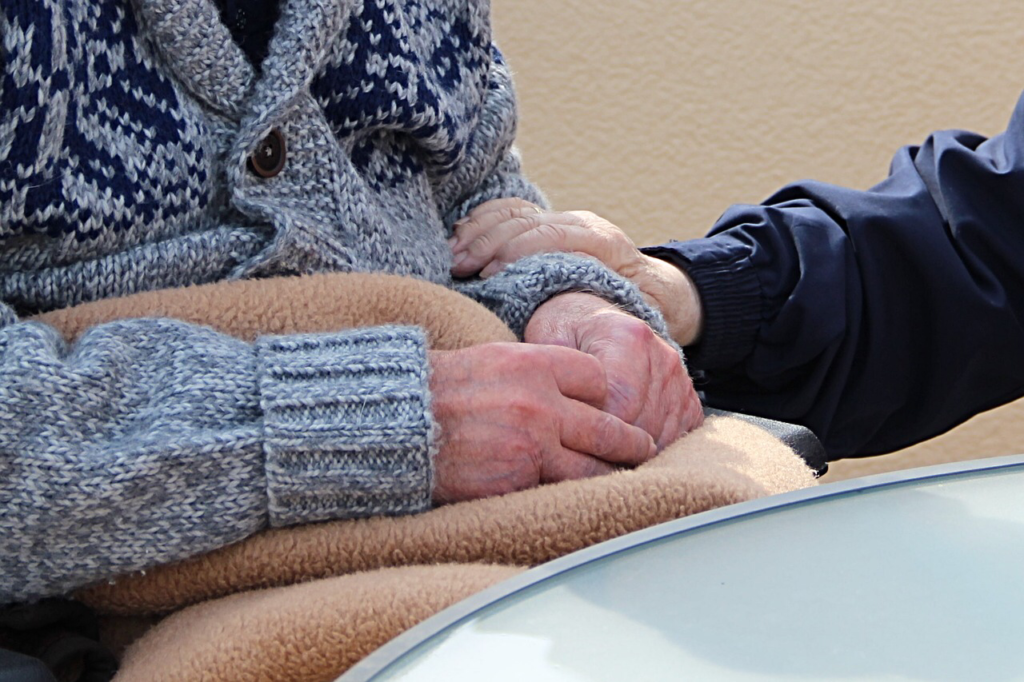Communicating with someone with Dementia can be made easier with some techniques. The damage in their brain has changed the way they hear, process and respond to conversations. That’s why it’s necessary to adapt the way we communicate to match their abilities.

How you talk is more important than what you say
In the approach of the person with Dementia, your attitude plays a major role. Contact between people largely consists of talking to each other. But people with Dementia are increasingly unable to do this. As a result, words play an increasingly smaller role in the contact, and your attitude becomes all the more important.
A large part of communication with someone with Dementia consists of body language or nonverbal communication. Your beloved family member or patient will understand you better if you support your words with gestures. Touch the person for a moment if you want to attract his or her attention (not unexpectedly from behind, he or she will be startled).
Body language is important
More than half of all communication is nonverbal. And your loved one or patient is becoming increasingly sensitive to nonverbal communication and body language. How you say something is more important than what you say. Even if you say something in words that he or she does not understand, they do understand your body language. From personal experience, I can even say that you don’t even have to speak the language of the person with Dementia. To make contact I use the universal language of the body language.
Therefore, always keep eye contact and talk with the use of your hands, your facial expression and your eyes. Touch him or her if that is reassuring. Your voice and tone are also important communication signals for the person with Dementia.
Conversely, the body language of your loved one or patient is an important source of information for you. From their body language, you can see how he or she feels and what they are trying to make clear to you.
The power of communicating differently
There are many different types of nonverbal Dementia communication:
Facial expressions
Your face can express emotions without saying a word. Have a pleasant or happy look on your face – a tense facial expression could cause distress and make communication more difficult.
Many facial expressions are the same across cultures, like happiness, sadness, anger, surprise, fear, and disgust.

Body movements and posture
The way someone moves and carries themselves can say a lot about them, their mood, and their state of mind. Watch for signs of frustration, anger, or fear and adjust your responses and actions to calm or soothe as needed.
Gestures
Project a positive and calm attitude. When we talk, we use gestures without even thinking about it – waving, pointing, and using our hands when we’re angry or excited. Avoid confusion by making sure your body language and facial expressions match the words you’re speaking.
Eye contact
For people who can see, vision is the dominant sense. That’s why eye contact is so important. The way you look at someone can say a lot. Approach from the front so they can see you coming and have a chance to process who you are and the fact that you’re going to interact with them.
Keep your face at or below their eye level, this helps them feel more in control of the situation. Make and maintain eye contact while having a conversation.

Touch
Touch is another way to “speak” without using words. For example, these mean very different things: a limp handshake, a gentle shoulder tap, a warm hug, a reassuring pat on the back, a patronizing pat on the head, or a controlling grip on the arm.

Space
Everyone needs some physical space, though how much may vary for each person and situation. Don’t stand too close or stand over them – it can feel intimidating. But staying at too far a distance could seem uncaring or uninterested.
Voice
The tone and volume of your voice add a lot of meaning to words. Keep your tone of voice positive and friendly.
Do’s and don’ts when approaching the person with Dementia:
Dementia may make it difficult for your loved one or patient to express themselves verbally.
Do’s
- Images say more than words and images from the past are more recognizable than images from today. For example, your loved one or patient will more easily recognize a retro-looking radio as a radio and be able to operate it better than a modern variant
- The head of your family member or patient works overtime. Give it a rest and do not do too much in one day. Ensure a fixed daily schedule with regular moments of rest.
- Exercise helps. Just walk or do some exercises with the arms and legs (in the next blog more about exercises).
- Stimulate the senses. If your loved one or patient sees a set table and smells the food, he or she will better understand what you mean when you say, “We’re going to eat.”
- Make sure you have the attention of your loved one or patient when you talk. Make sure he or she can see you well and make eye contact. Use short sentences. Give only one message per sentence and give him or her time to process what you said, because he or she may not immediately understand what you mean.
- If you want your loved one or patient to do something, ask him or her just before it should happen. Use short, focused questions and do not give more than one message at a time. Ask your question so that the chance of failure is the smallest. This way you prevent the person with Dementia from feeling insecure and afraid of doing things wrong.
- Use humor and act silly, especially if it makes you happy.
Don’ts
- Correct or contradict the person with Dementia; that confronts him or her with the things they no longer know or can do and makes them feel like they are failing;
- Talk in a loud voice or very quickly. Whispering is also not nice, that makes him or her suspicious;
- Test your loved one or patient by asking questions or by having them list the names of the children and grandchildren;
- Appear happier than you are. Your mood influences your loved one or patient, they will not understand why you are cheerful when you are not;
- Ask too much of your loved one. Because he or she can become confused or feel anxious and uncertain.
Conversation topics in the approach of the person with Dementia
During conversations with your loved one or patient, you will notice how often you talk in the past tense in daily use of speech. But that is always difficult for the person with Dementia to understand. “Did you sleep well?” is already a difficult question. Conversations are no longer intended to exchange information.
“I may not know who you are anymore, even though I have known you for a long time. Tell me who you are and how we know each other”. -Hans 95

You will have to get used to that. Yet, it is important to keep talking to your loved one or patient. By doing this you convey to him or her that you feel the warmth and that you pay attention to him or her. Your loved one or patient may not remember what you say, but they do enjoy your stories. Certainly, if you talk about something they can see, smell or touch at the moment, they will like it. Photos are a useful tool for this.
Communicate with images in the approach of the person with Dementia
When your loved one or patient has difficulty speaking, you can communicate and try if pictures work better. Make cards with photos or icons of words and actions that you use a lot. By showing a certain picture, you make clear to each other what you want to say.

Doing instead of talking in the approach of the person with Dementia
If talking is no longer possible, make it clear in another way that you are there for him or her. A touch, kiss or hug is a great way to show your affection. You can read to your loved one or patient and look at a book or photo album together. Go outside when the weather is nice and eat ice cream together. But you can also file the nails or gently massage their hands with cream.
“I gently squeezed my mother’s cheeks and said,” We have such a good time together.” She smiled. -Ingrid (59)

Often, the nonverbal messages we send with our body language and facial expressions come through more clearly than the words we speak.
